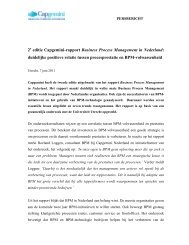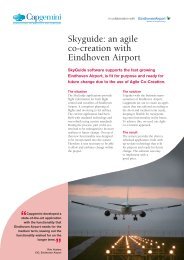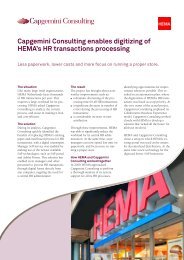IT transformations - Capgemini Consulting Nederland
IT transformations - Capgemini Consulting Nederland
IT transformations - Capgemini Consulting Nederland
Create successful ePaper yourself
Turn your PDF publications into a flip-book with our unique Google optimized e-Paper software.
Figure 3: Commercial LTE Deployments and Technology Adopted<br />
Operator Country Deployment Date Frequency Band Duplex Scheme<br />
Sweden<br />
Finland<br />
USA<br />
December 2009<br />
May 2010<br />
Sweden November 2010<br />
September 2010<br />
2.6GHz<br />
1.7/2.1GHz<br />
USA December 2010 700MHz<br />
Japan November 2010 2.1GHz<br />
Poland September 2010 1.8GHz<br />
FDD<br />
China May 2010 * 2.6GHz TDD<br />
* China Mobile has deployed 11 LTE trial networks across China. The first of these trial networks was launched in May<br />
2010.<br />
Source: <strong>Capgemini</strong> TME Strategy Lab Analysis; Company Websites<br />
efficiency and reduce OPEX. Thus,<br />
LTE offers the best potential to<br />
address one of the most significant<br />
priorities of wireless operators,<br />
which is, upgrading their capacity<br />
constrained networks.<br />
Having realized the potential,<br />
telcos across the globe have already<br />
taken the first steps towards the<br />
deployment of LTE networks (see<br />
Figure 3). In December 2009, by<br />
launching services in Sweden and<br />
Norway, TeliaSonera became the first<br />
operator in the world to offer LTE.<br />
In September 2010, Metro PCS, a<br />
prepaid service provider in the US,<br />
became the second operator to launch<br />
LTE services. It offers its service on<br />
the first commercially available 4G<br />
enabled handset in the world, the<br />
Samsung Craft 12 . While TeliaSonera,<br />
which is a GSM operator, offers<br />
its LTE services over USB dongles,<br />
Metro PCS, a CDMA2000 player,<br />
provides unlimited and contract less<br />
LTE services over a handset. It is<br />
noteworthy how LTE can be delivered<br />
by both large and small operators,<br />
irrespective of their existing wireless<br />
technology, over multiple devices.<br />
With over 100 commitments<br />
by service providers around the<br />
world to deploy LTE networks,<br />
the worldwide LTE infrastructure<br />
market is set to grow tenfold to<br />
reach US$11.5 billion 13 . Going<br />
by the trends, LTE seems to be<br />
the technology of choice for most<br />
operators across the world.<br />
In this chapter, we evaluate the<br />
technology options within LTE, the<br />
most significant barriers regarding<br />
its uptake, and recommend the best<br />
approach for different operators.<br />
Technology Options for<br />
Operators<br />
The technical advantages of LTE<br />
which render significant benefits<br />
over other wireless technologies can<br />
be attributed to its superior access<br />
and antenna technologies. The use<br />
of technologies such as OFDM 14 ,<br />
SC-FDMA 15 , MIMO, and multiple<br />
channel bandwidths results in<br />
attributes such as high throughput,<br />
low power consumption, high<br />
spectral efficiency, and improved<br />
coverage and cell performance. LTE<br />
can be deployed in both paired<br />
spectrum for Frequency Division<br />
Duplex (FDD) and unpaired spectrum<br />
for Time Division Duplex (TDD),<br />
and we witness a greater adoption<br />
of FDD in initial deployments (see<br />
Figure 3). In this section, we will<br />
primarily focus on the TDD and FDD<br />
technology deployment options for<br />
operators.<br />
Both FDD and TDD have their own<br />
advantages and disadvantages (See<br />
Figure 4), and decisions on which<br />
duplex scheme to adopt can be taken<br />
depending on the operator’s business<br />
requirements. In the subsequent<br />
subsections, we detail these choices.<br />
FDD LTE<br />
FDD LTE transmits the downlink and<br />
uplink traffic in separate frequency<br />
12 Company Press Release.<br />
13 Infonetics Research, LTE Infrastructure Forecasts Up, Along With Operator Commitments to LTE Networks, November 2010.<br />
14 Orthogonal Frequency Division Multiplexing: Used for downlink. The available spectrum is divided into many thin carriers each<br />
on a different frequency.<br />
15 Single Carrier Frequency Division Multiplexing Access: For uplink. LTE uses a pre-coded version of OFDM called Single<br />
Carrier Frequency Division Multiple Access (SC-FDMA) which reduces power consumption, improves coverage and the celledge<br />
performance.<br />
46
















